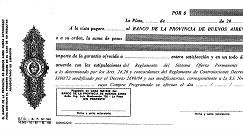When establishing the etymological origin of the word promissory note, we have to determine that it is clearly found in Latin and more precisely in the verb pacare , which can be translated as “to appease.” This meaning makes sense when you consider that paying something to someone is giving them something to calm them down, appease them, and that there are no problems of any kind.
A promissory note is an instrument that records an obligation to pay . The person who issues it, known as the subscriber , agrees to pay a second individual (the beneficiary or policyholder ) a certain amount of money within a stipulated period. For example: “Don't worry, tomorrow I'll give you a promissory note and we'll close the operation.”
 As a formal payment instrument, a promissory note must meet validity requirements . The document must include, either at the beginning or elsewhere, the word promissory note that identifies it as such. On the other hand, it must detail the amount of money that will be paid with its corresponding interest both in letters and numbers. It is important to keep in mind that the promissory note obligates payment on the stipulated date, which distinguishes it from the bill of exchange .
As a formal payment instrument, a promissory note must meet validity requirements . The document must include, either at the beginning or elsewhere, the word promissory note that identifies it as such. On the other hand, it must detail the amount of money that will be paid with its corresponding interest both in letters and numbers. It is important to keep in mind that the promissory note obligates payment on the stipulated date, which distinguishes it from the bill of exchange .
It is important to emphasize that on many occasions what a promissory note is is often confused with a bill of exchange, but it must be made clear that they are different elements. In this sense, and in addition to the above, we can state that one of the main differences that exist between them is that while the content of the aforementioned promissory note contains a promise to pay, in the letter what it includes is an order of pay.
In the same way, we cannot ignore the fact that when we refer to a letter of this type we are talking about a document where three personal subjects appear: the drawer, the drawee and the beneficiary. In the case of the promissory note, on the other hand, there are only two and they are the subscriber and the taker.
The name of the beneficiary (whether a natural or legal person), the date and place of payment, the date and place of signing, and the signature of the subscriber are also formal requirements of the promissory note.
Notes may be transmitted by endorsement, provided that the entire amount of the note is transmitted (i.e., only part of the note cannot be transmitted by endorsement).
Partial payment is an option that the subscriber has and that must be accepted by the policyholder, who will retain the document until full payment is received. The methodology indicates that, upon receiving a partial payment, the borrower must record it in the body of the promissory note and provide a receipt.
To conclude the analysis of this term we must also state that I will pay is the verbal form that corresponds to the first person singular of the future indicative of the verb pay. This is defined as the action through which someone makes satisfaction to another of what they owe them.
